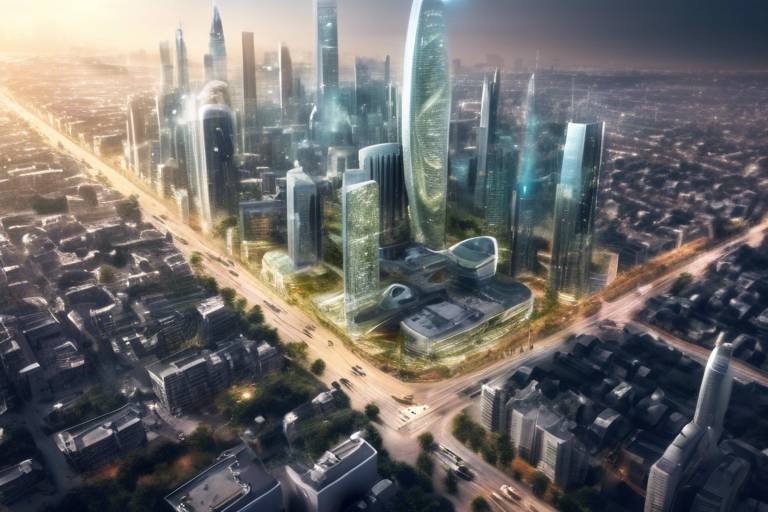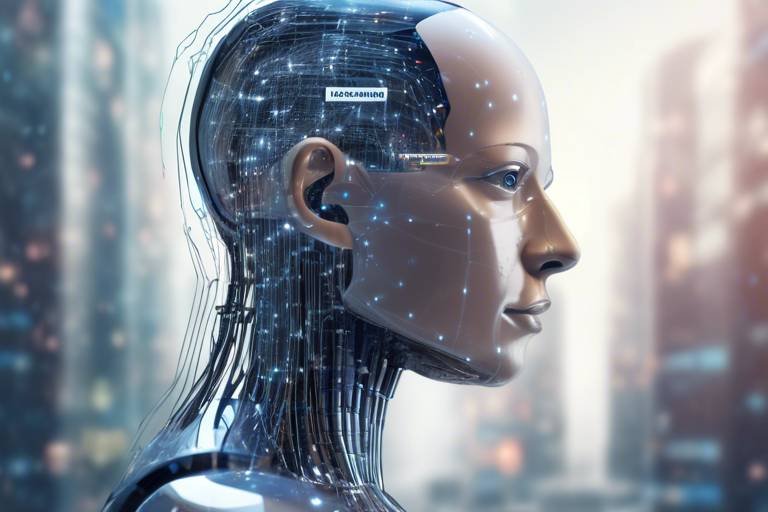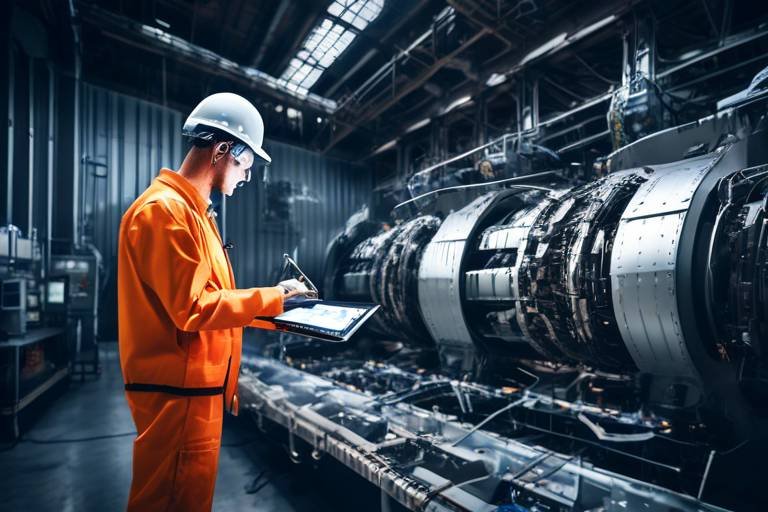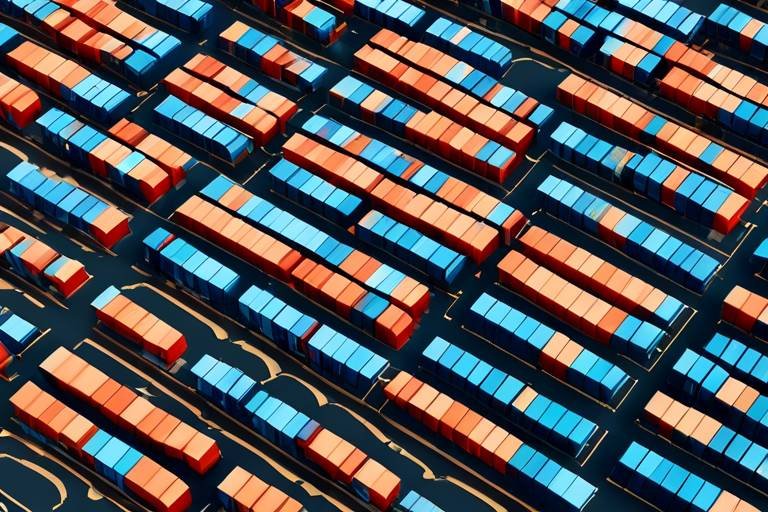Innovations in Energy Efficiency Technologies
In a world where energy consumption is skyrocketing and environmental concerns are more pressing than ever, are stepping up to the plate. These advancements not only promise to reduce energy waste but also pave the way for a more sustainable future. Imagine a world where your household appliances work smarter, your energy bills shrink, and your carbon footprint diminishes—all thanks to cutting-edge technology.
As we dive deeper into this topic, it's essential to understand that energy efficiency is not just a buzzword; it's a crucial component in the fight against climate change. By harnessing the power of technology, we can significantly enhance how we consume energy, leading to substantial cost savings and a healthier planet. From smart grids to energy-efficient appliances, the innovations emerging in this field are nothing short of revolutionary.
Take smart grids, for example. These systems use digital technology to monitor and manage energy flows more effectively than traditional grids. They create a two-way communication channel between consumers and utility providers, allowing for real-time adjustments that minimize waste and enhance reliability. With smart grids, energy distribution becomes a finely tuned orchestra, where each instrument plays its part in harmony, ensuring that power is delivered where and when it's needed most.
Moreover, the rise of energy-efficient appliances is transforming the way we interact with our homes. Today's appliances are not only designed to perform better but also to consume significantly less energy. This shift is largely driven by advancements in materials and technology, which allow devices to operate efficiently without sacrificing performance. For consumers, this means lower electricity bills and a reduced environmental impact.
Another fascinating area of innovation is in LED lighting. LEDs have completely revolutionized how we illuminate our spaces. With their low energy consumption and impressive lifespan, they offer an eco-friendly alternative to traditional bulbs. But the excitement doesn't stop there—advancements such as smart controls for lighting systems enable users to automate and remotely manage their lighting, optimizing energy use effortlessly. Imagine controlling your home’s lighting with just a tap on your smartphone!
Furthermore, the introduction of color-tunable LEDs adds a new dimension to lighting design. These innovative lights allow users to adjust color temperatures, creating the perfect ambiance for any occasion while improving energy efficiency. This flexibility is not only beneficial for residential settings but also enhances commercial environments, making spaces more inviting and functional.
As we look at larger structures, building automation systems are making waves in energy efficiency. By integrating various technologies, these systems optimize energy use in commercial buildings, resulting in significant sustainability and operational efficiency gains. Imagine a skyscraper that adjusts its heating, cooling, and lighting based on occupancy and time of day—this is the future of energy management!
In addition to these advancements, the integration of renewable energy sources into existing systems is vital for enhancing overall energy efficiency. Technologies facilitating this transition, such as solar and wind energy innovations, are reshaping our energy landscape. For instance, recent developments in solar panels and energy storage systems have made harnessing solar energy more efficient and accessible than ever before.
Wind energy, too, is undergoing a transformation. With advancements in turbine efficiency and offshore installations, wind energy is becoming a more viable and sustainable option for powering our homes and businesses. These developments are crucial in promoting a cleaner, greener energy future.
Finally, we cannot overlook the importance of energy storage solutions. Technologies like batteries and thermal storage play a pivotal role in energy efficiency by allowing us to store renewable energy for later use. This capability is essential for balancing supply and demand, ensuring that energy is available when we need it most.
In conclusion, the innovations in energy efficiency technologies are not merely enhancements; they are essential to our survival on this planet. By embracing these advancements, we can create a future that is not only sustainable but also economically viable. The journey towards energy efficiency is just beginning, and the possibilities are endless.
- What are smart grids? Smart grids are advanced electrical grids that use digital technology to monitor and manage energy flows, enhancing reliability and efficiency.
- How do energy-efficient appliances benefit consumers? They consume less energy, leading to lower electricity bills and a reduced environmental impact.
- What is the significance of LED lighting? LED lighting offers low energy consumption and a long lifespan, making it a sustainable choice for both residential and commercial spaces.
- How do building automation systems work? They integrate various technologies to optimize energy use in buildings, improving sustainability and operational efficiency.
- Why is energy storage important? Energy storage solutions allow for the use of renewable energy at times when it is most needed, balancing supply and demand effectively.

Smart Grids
Imagine a world where your energy consumption is not just a bill at the end of the month, but a dynamic interaction that optimizes your usage in real-time. are revolutionizing the way we think about energy management. By utilizing cutting-edge digital technology, these grids monitor and manage energy flows with unparalleled efficiency and reliability. They act like a conductor in an orchestra, ensuring that every note is played at the right time, harmonizing energy distribution across various sectors.
So, how exactly do smart grids achieve this? The secret lies in their ability to enhance communication between consumers and utilities. This two-way interaction allows for better energy distribution, minimizing waste and maximizing efficiency. For instance, during peak hours when energy demand surges, smart grids can automatically adjust the supply, redirecting energy to areas that need it most. This not only stabilizes the grid but also reduces the likelihood of blackouts, making our energy systems more resilient.
Furthermore, smart grids integrate various technologies, including smart meters and advanced sensors, to collect and analyze data. This data-driven approach empowers consumers to make informed decisions about their energy use. With real-time insights into their consumption patterns, users can identify opportunities to save energy and reduce costs. For example, if you notice that your energy usage spikes during certain hours, you can adjust your habits accordingly, leading to significant savings over time.
Let's not forget the environmental impact of smart grids. By optimizing energy distribution and reducing waste, these systems contribute to a more sustainable future. They facilitate the integration of renewable energy sources, such as wind and solar, into the grid. This means that as we move towards a greener energy landscape, smart grids will play a crucial role in ensuring that renewable energy is utilized efficiently.
In summary, smart grids are more than just a technological upgrade; they represent a fundamental shift in how we consume and manage energy. With their ability to enhance communication, improve efficiency, and promote sustainability, smart grids are paving the way for a brighter energy future. As we embrace these innovations, we must also consider how they can be further developed to meet the growing demands of our society.
To further illustrate the impact of smart grids, let's take a look at some key features:
| Feature | Description |
|---|---|
| Two-Way Communication | Allows real-time interaction between consumers and utilities. |
| Data Analytics | Utilizes data to optimize energy distribution and consumption. |
| Integration of Renewables | Facilitates the use of renewable energy sources, enhancing sustainability. |
| Improved Reliability | Reduces the risk of blackouts and stabilizes energy supply. |
As we look towards the future, it’s clear that smart grids will be at the forefront of energy efficiency technologies. They not only provide a pathway to a more sustainable energy landscape but also empower consumers to take control of their energy consumption. With ongoing advancements, we can expect even more innovative solutions that will redefine our relationship with energy.
- What is a smart grid? A smart grid is an electricity supply network that uses digital technology to monitor and manage the transport of electricity from all generation sources to meet the varying electricity demands of end users.
- How do smart grids benefit consumers? Smart grids provide consumers with real-time data on their energy usage, enabling them to make informed decisions and reduce their energy costs.
- Are smart grids environmentally friendly? Yes, smart grids facilitate the integration of renewable energy sources, reducing reliance on fossil fuels and minimizing environmental impact.
- What technologies are involved in smart grids? Key technologies include smart meters, advanced sensors, and data analytics systems that enhance communication and efficiency.

Energy-Efficient Appliances
In today's world, where every penny counts and the planet's health is more important than ever, have emerged as a game-changer. These modern marvels are designed to consume significantly less energy while still delivering top-notch performance. Imagine a refrigerator that uses less electricity than a standard light bulb—sounds unbelievable, right? Yet, that's the reality we live in thanks to advancements in technology and materials.
Energy-efficient appliances not only help in reducing energy bills but also play a crucial role in minimizing our carbon footprint. By opting for these appliances, consumers are making a conscious choice to invest in a sustainable future. The impact of these innovations extends beyond individual households; they contribute to a larger movement towards energy conservation and environmental responsibility.
Let’s take a closer look at some of the most common energy-efficient appliances that are making waves:
- Washing Machines: New models use advanced technology to adjust water levels and wash cycles based on the load size, ensuring that no energy or water is wasted.
- Dishwashers: Modern dishwashers are designed to clean dishes effectively while using less water and energy compared to hand washing.
- Refrigerators: Equipped with features like improved insulation and inverter technology, these fridges maintain optimal temperatures with minimal energy consumption.
- Ovens and Stoves: Innovations such as induction cooking not only cook food faster but also use energy more efficiently than traditional methods.
As we delve deeper into the world of energy-efficient appliances, we find that they come with a variety of features aimed at enhancing usability while conserving energy. For instance, many of these appliances now come with smart technology that allows users to monitor and control energy usage remotely. Imagine being able to check if you left the oven on while you’re at work, or adjusting your thermostat from your smartphone while on vacation! This level of control not only adds convenience but also ensures that energy is not wasted when it’s not needed.
To further illustrate the impact of these appliances, consider the following table that highlights the energy consumption of traditional appliances versus their energy-efficient counterparts:
| Appliance | Traditional Energy Consumption (kWh/year) | Energy-Efficient Energy Consumption (kWh/year) |
|---|---|---|
| Refrigerator | 800 | 400 |
| Washing Machine | 500 | 300 |
| Dishwasher | 600 | 300 |
| Oven | 150 | 100 |
As seen in the table, the energy savings can be substantial, leading to lower utility bills and reduced environmental impact. In fact, the U.S. Department of Energy estimates that switching to energy-efficient appliances can save a household up to $500 per year in energy costs. That’s money that can be spent on more enjoyable things, like a vacation or a nice dinner out!
In conclusion, the rise of energy-efficient appliances is not just a trend; it’s a necessary evolution in our approach to energy consumption. By embracing these innovative technologies, we’re not only saving money but also contributing to a more sustainable future. So, the next time you’re in the market for a new appliance, consider the benefits of energy efficiency. It’s a choice that pays off in more ways than one!
Q: What makes an appliance energy-efficient?
A: Energy-efficient appliances use advanced technology to reduce energy consumption while maintaining performance. They often have features like better insulation, smart technology, and optimized operating systems.
Q: How can I tell if an appliance is energy-efficient?
A: Look for the Energy Star label, which indicates that the appliance meets energy efficiency guidelines set by the U.S. Environmental Protection Agency. Additionally, check the appliance's energy consumption ratings.
Q: Are energy-efficient appliances more expensive?
A: While the initial cost may be higher, energy-efficient appliances typically save money in the long run through reduced energy bills. They are an investment in both your finances and the environment.

LED Lighting
LED lighting has truly transformed the way we illuminate our spaces, and it’s not just about the brightness. Imagine walking into a room filled with warm, inviting light that not only enhances your mood but also saves you money on your energy bill. That’s the magic of LED technology. Unlike traditional incandescent bulbs that waste a significant amount of energy as heat, LEDs are designed to be highly efficient, converting a larger percentage of energy into visible light. This efficiency translates into lower energy consumption and reduced greenhouse gas emissions, making LEDs a crucial player in the quest for sustainability.
One of the most remarkable advancements in LED technology is their long lifespan. While a standard incandescent bulb might last around 1,000 hours, an LED can shine for up to 25,000 hours or more. This longevity means fewer replacements, which not only saves you money but also reduces waste. Think about it: fewer trips to the hardware store and less hassle with changing bulbs. It’s a win-win situation!
Moreover, the versatility of LED lighting is astounding. They come in various shapes, sizes, and colors, making them suitable for a multitude of applications. Whether you're looking to brighten up your living room, create an ambiance in a restaurant, or enhance safety in outdoor spaces, LED lights can do it all. For instance, color-tunable LEDs allow users to adjust the color temperature according to their needs, which is particularly beneficial in settings like offices where different tasks require different lighting conditions.
Let’s take a closer look at some of the key benefits of LED lighting:
- Energy Efficiency: LEDs use up to 75% less energy than traditional bulbs.
- Durability: They are more robust and can withstand vibrations and impacts.
- Instant Lighting: LEDs reach full brightness instantly, unlike some other lighting types.
- Environmentally Friendly: They contain no toxic elements and are 100% recyclable.
As we move towards a more energy-efficient future, the adoption of LED lighting is becoming increasingly widespread in both residential and commercial settings. Businesses are recognizing the cost savings associated with lower energy bills and reduced maintenance costs, while homeowners appreciate the aesthetic appeal and energy savings. The shift towards LED lighting is not just a trend; it’s a revolution in how we think about lighting.
In summary, LED lighting is a shining example of how technology can enhance our lives while promoting sustainability. With its energy efficiency, long lifespan, and versatility, it’s clear that LEDs are not just a bright idea—they are the future of lighting.
1. How do LED lights compare to traditional bulbs in terms of energy consumption?
LED lights consume significantly less energy than traditional incandescent bulbs, using up to 75% less energy for the same amount of light output.
2. What is the average lifespan of an LED bulb?
LED bulbs can last anywhere from 15,000 to 50,000 hours, compared to traditional bulbs which typically last around 1,000 hours.
3. Are LED lights safe for the environment?
Yes, LED lights are environmentally friendly as they contain no toxic materials and are 100% recyclable, reducing waste in landfills.
4. Can LED lights be used in outdoor settings?
Absolutely! LEDs are durable and can withstand outdoor conditions, making them ideal for outdoor lighting solutions.

Smart Controls
When it comes to enhancing energy efficiency, are like the brains of the operation. Imagine walking into a room and having the lights adjust automatically to your preferred brightness, or the thermostat learning your schedule and optimizing heating and cooling without you lifting a finger. This is not just a dream anymore; it's the reality brought to life by smart control technologies. These systems utilize advanced algorithms and real-time data to manage energy consumption intelligently, making our homes and offices more efficient than ever.
One of the most exciting aspects of smart controls is their ability to integrate with various devices and systems. For instance, with a smart lighting system, you can control your lights remotely through a smartphone app or even voice commands. This level of control not only enhances convenience but also leads to significant energy savings. By scheduling lights to turn off when not needed or dimming them during daylight hours, users can reduce their energy bills while contributing to a more sustainable environment.
Moreover, smart controls can be programmed to respond to environmental changes. For example, sensors can detect when a room is unoccupied and automatically turn off lights and adjust the thermostat accordingly. This is akin to having a personal assistant who ensures that energy is not wasted. In a commercial setting, such systems can analyze usage patterns and optimize energy distribution, resulting in operational efficiencies that can save businesses a substantial amount of money.
To illustrate the impact of smart controls, consider the following table that compares traditional energy management systems with smart control systems:
| Feature | Traditional Systems | Smart Control Systems |
|---|---|---|
| Energy Monitoring | Manual tracking | Real-time analytics |
| Control Method | Manual switches | Remote access and automation |
| Adaptability | Static settings | Dynamic adjustments based on usage |
| Cost Savings | Minimal | Significant long-term savings |
As we move towards a more energy-conscious society, the role of smart controls cannot be overstated. They not only enhance our daily lives by providing convenience but also play a crucial role in reducing our carbon footprint. The integration of these technologies is paving the way for a future where energy efficiency is the norm rather than the exception. With the rise of the Internet of Things (IoT), we can expect even greater advancements in this area, allowing for seamless connectivity and smarter energy solutions.
In conclusion, smart controls represent a significant leap forward in energy efficiency technologies. They empower users to take charge of their energy consumption, leading to both financial savings and a more sustainable lifestyle. As we embrace these innovations, we are not just making our lives easier; we are also contributing to a healthier planet.
- What are smart controls? Smart controls are advanced systems that manage energy consumption through automation and real-time data analysis.
- How do smart controls save energy? They optimize energy use by adjusting settings based on occupancy, time of day, and environmental conditions.
- Can I control smart systems remotely? Yes, most smart control systems can be accessed and managed through smartphone apps or voice commands.
- Are smart controls expensive to install? While the initial investment may be higher than traditional systems, the long-term energy savings often outweigh the costs.

Color-Tunable LEDs
Color-tunable LEDs are not just a trend; they're a game changer in the world of lighting technology. Imagine being able to adjust the ambiance of your space with just a touch of a button. Whether you're hosting a dinner party, winding down after a long day, or creating a productive workspace, color-tunable LEDs provide the flexibility to set the perfect mood. With advancements in technology, these LEDs allow users to switch between various color temperatures, from warm yellows to cool blues, enhancing the aesthetic appeal of any environment.
One of the most exciting aspects of color-tunable LEDs is their energy efficiency. By enabling users to select the optimal lighting for specific tasks or times of day, these lights can significantly reduce energy consumption. For instance, using cooler light during the day can help improve alertness and productivity, while warmer light in the evening can promote relaxation. This adaptability not only benefits the user but also contributes to a more sustainable energy consumption model.
Moreover, the integration of smart technology into color-tunable LEDs has ushered in a new era of automation. Imagine walking into a room, and the lights automatically adjust to your preferred settings based on the time of day or activity. This level of control can lead to substantial energy savings, as lights can be programmed to dim or change color when not in use. Additionally, many of these systems can be controlled remotely via smartphone applications, giving users unprecedented control over their lighting environment.
To illustrate the impact of color-tunable LEDs on energy efficiency, consider the following table that compares traditional lighting systems with color-tunable LED systems:
| Feature | Traditional Lighting | Color-Tunable LEDs |
|---|---|---|
| Energy Consumption | High | Low |
| Color Options | Fixed | Variable |
| Control Methods | Manual Switch | Smartphone & Automation |
| Lifespan | Short | Long |
In summary, color-tunable LEDs are revolutionizing the way we think about lighting. They not only enhance the aesthetic quality of our spaces but also contribute significantly to energy efficiency and sustainability. As more people recognize the benefits of these innovative lighting solutions, we can expect to see a broader adoption across both residential and commercial settings. The future of lighting is bright, quite literally, and it's time to embrace the versatility and efficiency that color-tunable LEDs offer.
- What are color-tunable LEDs? Color-tunable LEDs are lighting systems that allow users to adjust the color temperature of the light, providing flexibility for different settings and moods.
- How do color-tunable LEDs save energy? By allowing users to select the optimal lighting for specific tasks or times of day, they can reduce energy consumption compared to traditional fixed-color lighting.
- Can color-tunable LEDs be controlled remotely? Yes, many color-tunable LED systems can be controlled via smartphone apps, enabling users to adjust settings from anywhere.
- Are color-tunable LEDs suitable for all environments? Absolutely! They are versatile enough to be used in residential, commercial, and even industrial settings, enhancing both functionality and ambiance.

Building Automation Systems
Building Automation Systems (BAS) are the unsung heroes of modern architecture, seamlessly integrating technology to optimize energy use in commercial buildings. Imagine a world where your office lights, heating, ventilation, and air conditioning (HVAC) systems work in perfect harmony, adjusting themselves automatically based on occupancy and environmental conditions. That’s the magic of BAS! These systems utilize advanced sensors and controls to monitor real-time data, allowing for intelligent decision-making that not only enhances comfort but also significantly reduces energy consumption.
At the heart of BAS lies a network of devices that communicate with each other to create a cohesive energy management strategy. For instance, when a room is unoccupied, the system can automatically dim the lights and adjust the temperature, ensuring that energy isn’t wasted. This level of automation translates to substantial cost savings and a smaller carbon footprint, making BAS a key player in the pursuit of sustainability.
Furthermore, the integration of Building Management Systems (BMS) with Internet of Things (IoT) technology has taken energy efficiency to a whole new level. With IoT-enabled sensors, buildings can collect vast amounts of data, enabling predictive maintenance and real-time monitoring. This means that potential issues can be identified and resolved before they escalate, ensuring the systems operate at peak efficiency. The result? A more reliable building that not only meets the needs of its occupants but also aligns with global sustainability goals.
To illustrate the benefits of BAS, consider the following table that outlines the key components and their contributions to energy efficiency:
| Component | Function | Energy Efficiency Benefit |
|---|---|---|
| Sensors | Monitor occupancy and environmental conditions | Reduces unnecessary energy use |
| Controllers | Automate systems based on data inputs | Optimizes performance and reduces waste |
| Software | Analyze data for insights and reporting | Informs strategic energy management decisions |
| Communication Networks | Facilitate real-time data exchange | Enhances system responsiveness and efficiency |
In addition to these components, BAS can also integrate with renewable energy sources, such as solar panels and wind turbines, to further enhance energy efficiency. By harnessing the power of these technologies, buildings can reduce their reliance on traditional energy sources, leading to even greater sustainability outcomes. Imagine a skyscraper that not only operates on clean energy but also contributes surplus energy back to the grid—now that’s a vision for the future!
As we move forward, the role of Building Automation Systems will only become more critical. With the push for smarter cities and sustainable living, investing in BAS is not just a trend; it's a necessity. By adopting these innovative technologies, businesses can not only save on operational costs but also play a vital role in protecting our planet for future generations.
- What are Building Automation Systems?
Building Automation Systems are integrated technologies that manage a building's mechanical, electrical, and electromechanical systems to enhance efficiency and comfort. - How do BAS contribute to energy savings?
BAS optimize energy use by automating systems based on real-time data, reducing waste and ensuring that energy is only used when necessary. - Can BAS integrate with renewable energy sources?
Yes! BAS can work alongside renewable energy technologies, allowing buildings to maximize their energy efficiency and sustainability. - What is the future of Building Automation Systems?
The future of BAS looks promising, with advancements in IoT and AI leading to smarter, more efficient buildings that contribute positively to energy conservation efforts.

Renewable Energy Integration
In today's world, the integration of renewable energy sources into our existing energy systems is not just a trend; it’s a necessity. As we strive to combat climate change and reduce our carbon footprint, the shift towards renewable energy has become more critical than ever. This section delves into the various technologies that facilitate this transition, showcasing their immense benefits for both the environment and our economy. By harnessing the power of the sun, wind, and other renewable sources, we can create a more sustainable and efficient energy landscape.
One of the most significant advancements in renewable energy integration is the development of smart grid technology. Smart grids utilize digital communication tools to manage electricity flow from all generation sources, including renewables. This technology not only enhances the reliability of energy supply but also allows for better management of energy consumption. Imagine a world where your home’s energy use is optimized in real-time, adjusting automatically based on available renewable energy. This is the future that smart grids are paving the way for.
Furthermore, the integration of renewable energy is also facilitated by energy management systems that help consumers and businesses monitor their energy usage. These systems can analyze data to provide insights on how to reduce energy waste and increase efficiency. For instance, a business that utilizes solar panels can store excess energy generated during the day and use it during peak hours, significantly lowering operational costs.
Moreover, technologies such as microgrids are emerging as game-changers in the realm of renewable energy integration. A microgrid is a localized energy system that can operate independently or in conjunction with the main grid. This allows for greater resilience and reliability, especially in areas prone to power outages. By integrating renewable sources like solar and wind within these microgrids, communities can achieve energy independence and sustainability.
To illustrate the impact of renewable energy integration, consider the following table, which highlights the benefits of various renewable sources:
| Renewable Energy Source | Benefits |
|---|---|
| Solar Energy | Reduces electricity bills, low maintenance costs, and decreases greenhouse gas emissions. |
| Wind Energy | Provides a clean energy source, creates jobs, and promotes energy independence. |
| Hydropower | Reliable and consistent energy, flood control, and irrigation support. |
| Geothermal Energy | Low emissions, sustainable, and provides a constant energy supply. |
As we look to the future, the integration of renewable energy sources will continue to evolve. Innovations in battery storage technologies are also playing a crucial role in this transition. By enabling the storage of excess energy generated during peak production times, these technologies ensure that renewable energy can be utilized even when the sun isn’t shining or the wind isn’t blowing. This capability is essential for maintaining a steady and reliable energy supply.
In conclusion, the integration of renewable energy is not merely an option; it’s an imperative for a sustainable future. By embracing these technologies, we can significantly reduce our reliance on fossil fuels, lower emissions, and create a cleaner planet for future generations. As we continue to innovate and invest in renewable energy, the possibilities for a sustainable and energy-efficient world are endless.
- What is renewable energy integration?
Renewable energy integration refers to the process of incorporating renewable energy sources, like solar and wind, into existing energy systems to create a more sustainable and efficient energy landscape. - Why is renewable energy integration important?
It is crucial for reducing carbon emissions, combating climate change, and ensuring a reliable energy supply that is less dependent on fossil fuels. - What technologies support renewable energy integration?
Technologies such as smart grids, energy management systems, microgrids, and advanced battery storage solutions play significant roles in enabling renewable energy integration.

Solar Energy Innovations
Solar energy has emerged as a powerhouse of renewable energy, playing a pivotal role in our transition towards a sustainable future. The latest innovations in solar technology not only enhance energy efficiency but also make solar power more accessible and affordable. One of the most remarkable advancements is the development of high-efficiency solar panels. These panels utilize cutting-edge materials, such as monocrystalline silicon, which allows for greater energy absorption and conversion rates. As a result, homeowners and businesses can generate more electricity from the same amount of sunlight, significantly reducing their energy bills.
Another exciting innovation is the emergence of solar energy storage systems. These systems, including advanced lithium-ion batteries, enable users to store excess energy generated during sunny days for use during cloudy periods or at night. This capability not only maximizes the utility of solar energy but also enhances grid stability. Imagine a world where your home is powered by the sun, even when the sun isn’t shining! This dream is becoming a reality thanks to these technological advancements.
Moreover, the integration of smart technology into solar energy systems is revolutionizing how we manage energy consumption. With smart inverters and monitoring systems, users can track their energy production in real-time, optimize their energy usage, and even sell excess energy back to the grid. This creates a dynamic energy ecosystem where consumers are not just passive users but active participants in energy production and distribution.
To give you a clearer picture of how these innovations stack up, here’s a quick comparison of traditional solar panels versus the latest high-efficiency models:
| Feature | Traditional Solar Panels | High-Efficiency Solar Panels |
|---|---|---|
| Efficiency Rate | 15-18% | 20-25% |
| Space Requirement | More space needed | Less space needed |
| Cost | Lower initial cost | Higher initial cost, but more savings over time |
| Lifespan | 25 years | 25-30 years |
In addition to these advancements, solar thermal technology is gaining traction. This method captures sunlight to produce heat, which can be used for residential heating or to generate electricity. By harnessing the sun's heat, we can reduce our reliance on fossil fuels even further. It's like having a cozy blanket of sunlight wrapped around your home, providing warmth without the hefty energy bills!
As we look to the future, the combination of these innovations is set to transform the solar landscape. With continued research and investment, we can expect even more breakthroughs that will drive down costs and increase efficiency. The goal is clear: to make solar energy a viable option for everyone, paving the way for a cleaner, greener planet.
- What are the benefits of using solar energy? Solar energy reduces electricity bills, lowers carbon footprints, and increases energy independence.
- How long do solar panels last? Most solar panels have a lifespan of 25 to 30 years, depending on the type and maintenance.
- Can solar energy work in cloudy weather? Yes! Solar panels can still generate electricity on cloudy days, though at a reduced rate.
- What is net metering? Net metering allows solar panel owners to sell excess electricity back to the grid, further reducing their utility costs.

Wind Energy Developments
In recent years, the landscape of wind energy has undergone remarkable transformations, driven by technological advancements and an increasing commitment to sustainable practices. One of the most significant developments is the enhancement of turbine efficiency. Modern wind turbines are not only taller but also equipped with larger blades that can capture more wind energy, even in low-wind conditions. This means that they can generate power more consistently and effectively than their predecessors. Think of it like upgrading from a small fan to a high-powered wind turbine—suddenly, the potential for energy generation skyrockets!
Another exciting trend is the rise of offshore wind farms. These installations are strategically placed in bodies of water where wind speeds are typically higher and more consistent. Offshore wind energy is becoming a game changer, as it allows for larger turbines that can harness the full potential of the wind without the constraints often found on land. The vast open space of oceans and seas provides an opportunity for massive wind farms that can generate electricity for millions of homes. For instance, the Hornsea One project in the UK, which is currently the largest offshore wind farm in the world, is capable of powering over a million homes!
Moreover, innovations in materials science are contributing significantly to the durability and efficiency of wind turbines. Manufacturers are now utilizing advanced composites that make blades lighter yet stronger. This not only reduces the amount of energy required to manufacture the turbines but also extends their lifespan and reduces maintenance costs. Imagine a lightweight, yet incredibly strong material that can withstand harsh weather conditions—this is the future of wind turbine design!
Additionally, the integration of artificial intelligence (AI) and machine learning into wind energy systems is a game changer. These technologies allow for real-time monitoring and predictive maintenance, ensuring that turbines operate at peak efficiency. By analyzing data from thousands of sensors, AI can predict when a turbine is likely to require maintenance, thus minimizing downtime and maximizing energy output. It’s like having a personal trainer for your wind turbines, constantly optimizing their performance!
Finally, the global push for renewable energy sources has led to increased investment in wind energy projects. Governments and private sectors are collaborating to create incentives for wind energy development, making it a more attractive option for investors. With the cost of wind energy continuing to decline, it is becoming one of the most economically viable sources of renewable energy available today. In fact, according to a recent report, the cost of onshore wind energy has dropped by 70% since 2009, making it a powerhouse in the renewable sector.
In summary, wind energy developments are paving the way for a greener and more sustainable future. With advancements in turbine technology, offshore installations, innovative materials, and the integration of AI, the wind energy sector is not just surviving; it’s thriving. As we continue to harness the power of the wind, we are taking significant steps toward a sustainable energy future that benefits both the environment and our economy.
- What are the benefits of wind energy? Wind energy is renewable, reduces greenhouse gas emissions, and can lead to lower electricity costs.
- How do wind turbines work? Wind turbines convert kinetic energy from the wind into mechanical energy, which is then converted into electricity.
- Are wind farms noisy? Modern wind turbines are designed to operate quietly, and the noise levels are generally comparable to that of a refrigerator.
- What is the future of wind energy? The future looks bright with ongoing advancements in technology, increasing efficiency, and greater integration into the energy grid.

Energy Storage Solutions
In today's rapidly evolving energy landscape, are becoming increasingly vital. These technologies not only allow us to harness renewable energy more effectively but also play a crucial role in enhancing overall energy efficiency. Imagine a world where the sun shines bright during the day, and instead of wasting that energy, we can store it for use during the night. That's the promise of energy storage!
At the heart of this revolution are various types of energy storage technologies, including batteries and thermal storage systems. Each of these technologies has its unique advantages and applications. For instance, batteries, particularly lithium-ion batteries, have gained popularity due to their efficiency and decreasing costs. They are widely used in electric vehicles and grid storage, allowing for a seamless transition from renewable energy sources to daily consumption.
On the other hand, thermal storage systems, which store energy in the form of heat, are particularly effective in buildings and industrial applications. These systems can absorb excess heat generated during peak hours and release it when demand is high, effectively balancing energy supply and demand. This not only reduces energy costs but also minimizes the strain on the grid during peak usage times.
Let's take a closer look at some of the most prominent energy storage technologies:
| Technology | Description | Advantages |
|---|---|---|
| Lithium-Ion Batteries | Rechargeable batteries commonly used in consumer electronics and electric vehicles. | High energy density, long cycle life, decreasing costs. |
| Flow Batteries | Use liquid electrolytes to store energy, suitable for large-scale applications. | Scalable, long-duration discharge, less degradation over time. |
| Thermal Energy Storage | Stores energy in the form of heat for later use. | Cost-effective for heating applications, reduces peak load. |
As we move forward, the integration of these storage solutions with renewable energy sources becomes paramount. For example, pairing solar panels with battery storage systems allows homeowners to utilize solar energy even when the sun isn't shining. This not only maximizes the use of renewable resources but also reduces dependence on fossil fuels.
Moreover, the ongoing advancements in energy storage technologies are paving the way for a more sustainable future. Researchers are exploring new materials and methods to enhance the efficiency and capacity of batteries. Innovations like solid-state batteries promise to deliver even greater energy density and safety. This means that in the near future, we might see electric vehicles traveling longer distances on a single charge, and homes powered entirely by clean energy.
In conclusion, energy storage solutions are not just a trend; they are a necessity for a sustainable energy future. By enhancing the efficiency of energy consumption and enabling the integration of renewable resources, these technologies are transforming the way we think about energy. As we continue to innovate and invest in energy storage, the possibilities are endless!
- What are energy storage solutions? Energy storage solutions are technologies that capture and store energy for later use, helping to balance supply and demand, especially with renewable energy sources.
- Why are energy storage solutions important? They enhance energy efficiency, reduce reliance on fossil fuels, and allow for better integration of renewable energy into the grid.
- What types of energy storage technologies are available? Common types include lithium-ion batteries, flow batteries, and thermal energy storage systems.
- How do energy storage solutions benefit consumers? They can lower energy costs, provide backup power, and increase the use of renewable energy sources, contributing to a more sustainable energy future.
Frequently Asked Questions
- What are smart grids and how do they improve energy efficiency?
Smart grids are advanced electrical grids that use digital technology to monitor and manage energy flows. By enhancing communication between consumers and utilities, they allow for better energy distribution, reducing waste and improving overall reliability. Imagine a highway system that adjusts traffic lights based on real-time traffic conditions; that's how smart grids optimize energy use!
- How do energy-efficient appliances help in saving costs?
Energy-efficient appliances are designed to consume less energy while delivering the same performance. This means lower utility bills for consumers and a reduced environmental footprint. Think of it like switching from a gas-guzzler to a fuel-efficient car—you're saving money at the pump while also helping the planet!
- What are the benefits of LED lighting compared to traditional lighting?
LED lighting is a game-changer! It consumes significantly less energy and has a much longer lifespan than traditional bulbs. This means fewer replacements and lower electricity bills. Plus, with advancements in LED technology, you can enjoy better quality light that enhances your space—it's like upgrading from a flip phone to a smartphone!
- What role do building automation systems play in energy efficiency?
Building automation systems integrate various technologies to control and optimize energy use in commercial buildings. By automating lighting, heating, and cooling, these systems minimize energy waste and improve operational efficiency. It's like having a smart home, but on a larger scale—everything works together to save energy!
- How does renewable energy integration enhance energy efficiency?
Integrating renewable energy sources like solar and wind into existing systems is crucial for enhancing energy efficiency. It allows for the use of clean energy, reducing reliance on fossil fuels. Think of it as switching from a coal-powered train to a solar-powered one; you're not just saving energy, but also making a sustainable choice for the future!
- What are the latest innovations in solar energy technology?
Recent innovations in solar technology include more efficient solar panels and advanced energy storage systems. These advancements allow for better energy capture and storage, making solar power more accessible and effective. It's like upgrading your phone's battery; you can use it longer without worrying about running out of juice!
- Why are energy storage solutions important for energy efficiency?
Energy storage solutions, such as batteries and thermal storage, are vital because they enable the use of renewable energy when it's available, even if demand is high later. This helps balance supply and demand, making energy systems more efficient. Imagine having a savings account for your energy; you can draw from it whenever you need, ensuring you never run out!



















